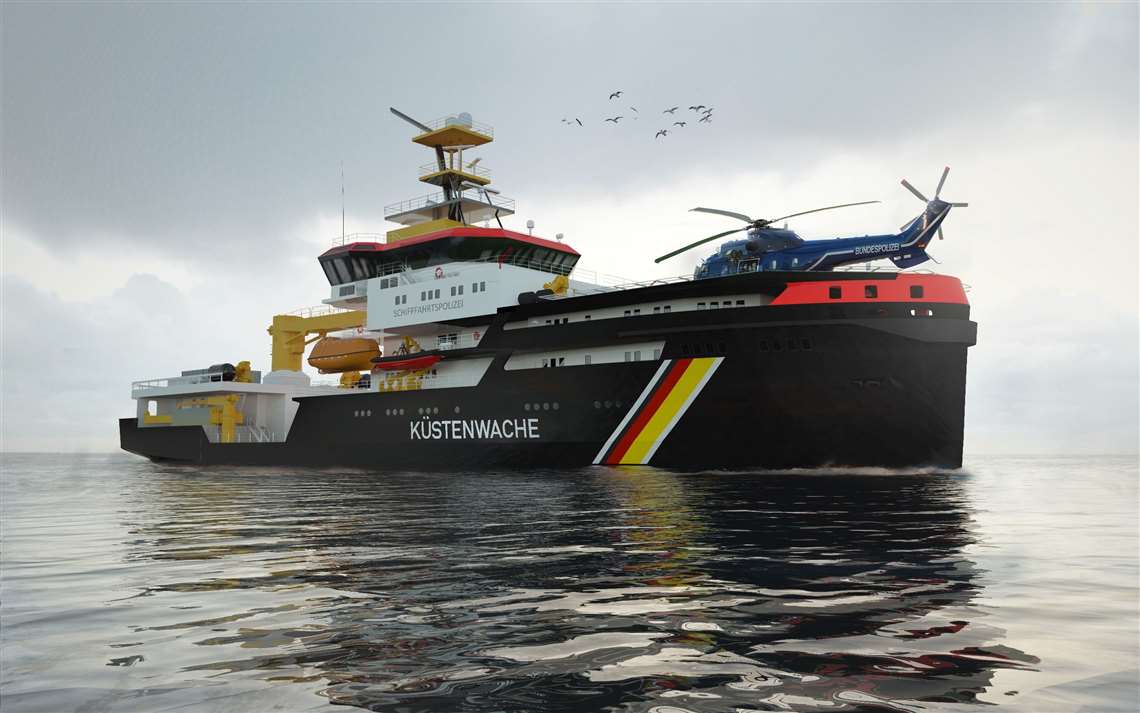Three multi-purpose vessels ordered
16 March 2021
Engines specifically designed for use in explosive environments
Three new multi-purpose vessels ordered from the Abeking & Rasmussen ship and yacht shipyard (A&R) in Lemwerder by the German government for the Waterways and Shipping Administration (WSV) will be equipped with Schottel propulsion systems and Bergen liquefied natural gas (LNG) engines.
Planning and design as well as tendering and continuous construction supervision are carried out by the Federal Waterways Engineering and Research Institute (BAW), Ship Technology division.
Maneuverability, high bollard pull, increased availability combined with maximum propulsion efficiency are important for these vessels, according to Schottel. These requirements are met by means of two Schottel RudderPropellers and one PumpJet per vessel.
One of the technical special features of the multi-purpose vessels is the exclusive use of the LNG. In order to safely carry out firefighting missions in toxic or explosive environments, A&R said it further developed the already tried and tested technologies. The shipbuilder said it worked to ensure no methane gas leakage occurs, which is of vital importance during firefighting operations. The entire LNG- and piping systems are double-coated and encased in protective gas. In the unlikely instance of gas leakage, methane stays trapped in the protective casing.
The B36:45L6AG LNG-engines are also specifically designed to be safely used in explosive environments. According to A&R, Bergen Engines, which is part of Rolls-Royce, will be supported in this enterprise by its sister company MTU Friedrichshafen. Whereas the Norwegian engine manufacturer capitalizes on its longstanding experience and competence in designing and manufacturing LNG-engines, the MTU has been developing engines used in exactly such special missions since 1986, A&R said.
Each of the identical WSV special vessels, which are over 90 m long, is driven by two Schottel RudderPropellers type SRP 750 (each 4500 kW at 750 rpm). This allows the vessels to reach a speed of over 15 knots and a bollard pull of at least 145 tonnes. With an input power of up to 5300 kW, the SRP 750 is one of the most powerful rudder propellers in the entire Schottel portfolio.
 German shipbuilder Abeking and Rasmussen has been selected to build three emergency response vessels in a series for the country’s Federal Waterways and Shipping Administration
German shipbuilder Abeking and Rasmussen has been selected to build three emergency response vessels in a series for the country’s Federal Waterways and Shipping Administration
A Schottel PumpJet type SPJ 520 (2990 kW) further increases the maneuverability of the vessels and is also suitable for operation in shallower waters thanks to being installed flush with the hull. The SPJ is mounted elastically, which reduces noise and vibration levels on board as well as underwater noise.
In addition, all three vessels will be equipped with Schottel MariHub, Schottel’s data acquisition and IoT gateway system. It records and analyses signals from sensors, machinery and other components which can then be evaluated by Schottel for the customer.
The tasks of the multi-purpose vessels include working on sea marks, performing waterways police missions, combating pollutant spills and fighting fires, emergency towing within the scope of maritime emergency preparedness guidelines, taking care of injured persons at sea and the deployment of hydroacoustic equipment. Besides the 16 crew members, up to thirty-four additional forces can be accommodated on board. Extensive equipment is on board in order to carry out emergency towing operations successfully.
The three new vessels will replace the multi-purpose vessels Mellum, Scharhörn and Neuwerk. The vessels which are approved for worldwide deployment will operate in German coastal waters in the North Sea and Baltic Sea.
The first of the new special vessels is scheduled to enter service in 2023, the second a year later and the third in 2025.
POWER SOURCING GUIDE
The trusted reference and buyer’s guide for 83 years
The original “desktop search engine,” guiding nearly 10,000 users in more than 90 countries it is the primary reference for specifications and details on all the components that go into engine systems.
Visit Now
STAY CONNECTED




Receive the information you need when you need it through our world-leading magazines, newsletters and daily briefings.
CONNECT WITH THE TEAM










